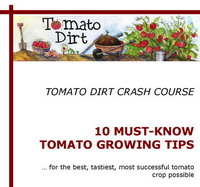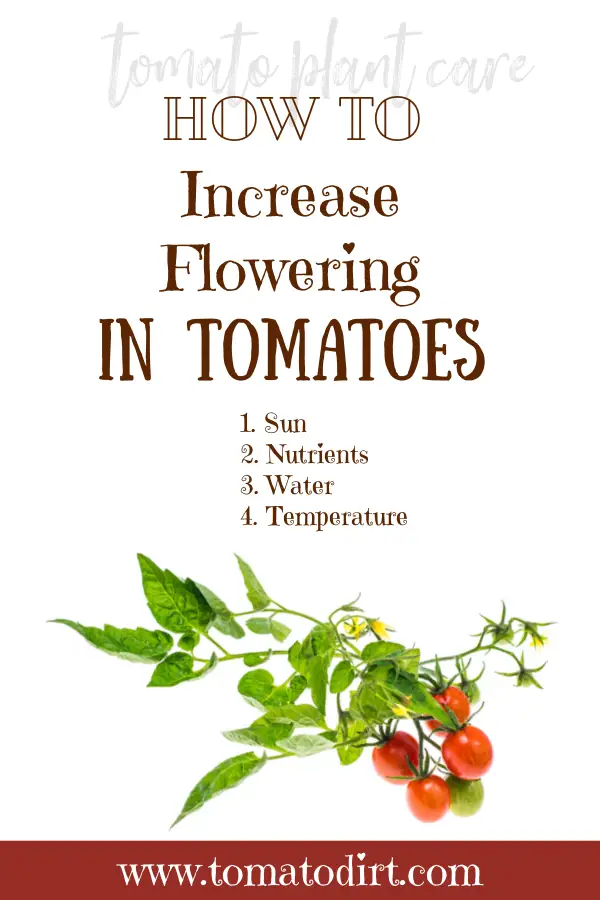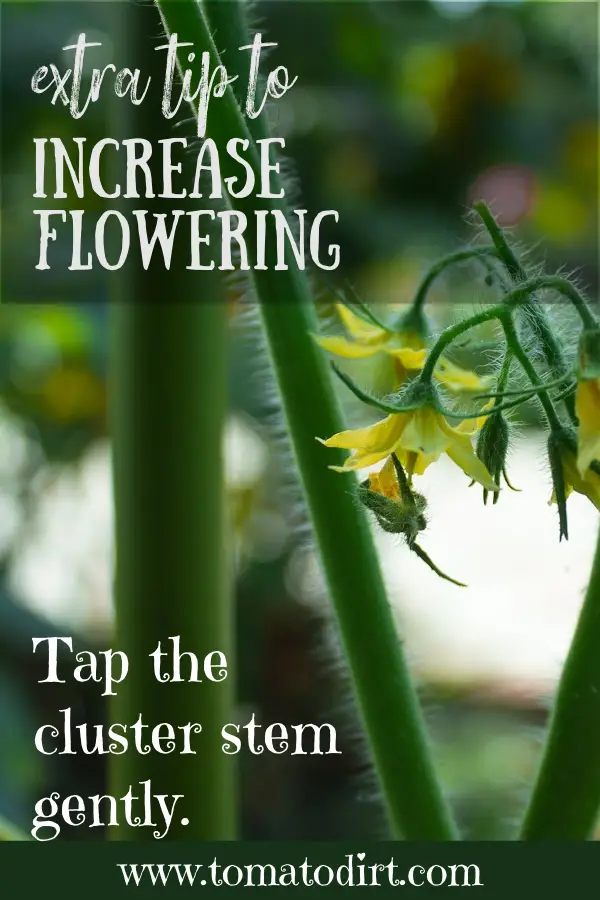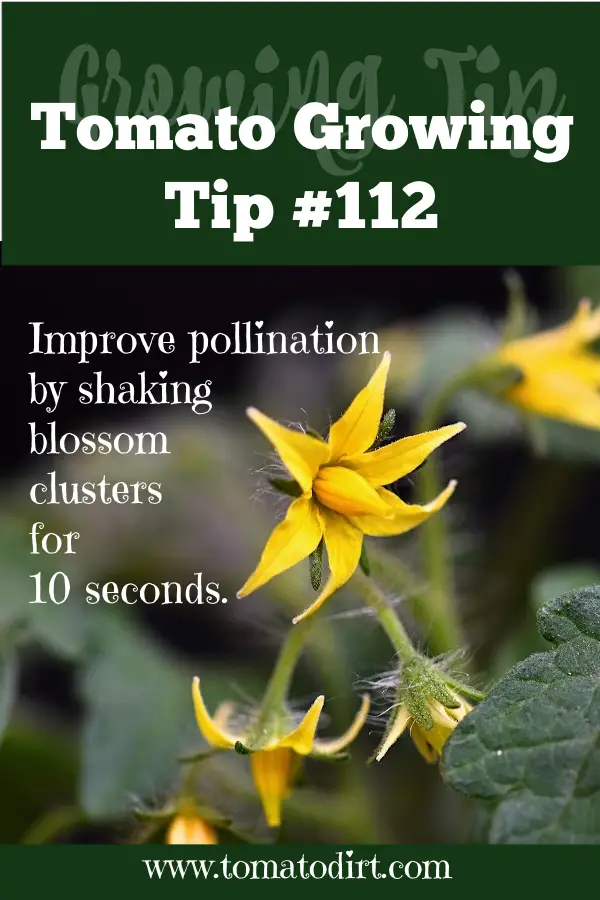FREE: 10 Must-Know Tomato Growing Tips Get The Guide
Read our affiliate disclosure here.
How to Increase Flowering in
Tomatoes
Since 2010, Tomato Dirt has garnered 4.8+ million views, making it the web’s leading online source for growing tomatoes in the home garden. Award-winning writer and Tomato Dirt owner Kathy Widenhouse has helped thousands of home gardeners grow healthier tomatoes. Be one of them when you get Tomato Dirt’s Growing Guide here.
Posted 7.10.25
More flowers, more fruit. Which is why every gardener wants to know how to increase flowering in tomatoes.
Here’s the dirt: tomatoes produce flowers when they have the sun, nutrients, water, and temperature they need to thrive. Without those elements, they’re stressed.
Stress: you know what it’s like. Stressed people simply try to survive. Likewise, stressed tomato plants simply try to survive.
Remove the stress and you have the chance to flourish. The same is true for your tomato plants. If you give them But if you give tomato plants an ideal environment, they have the energy to produce lots of flowers and fruit.
Tomatoes typically begin flowering about 1 month after they are transplanted in the ground. Small yellow flowers first develop on plants that are 12-18” tall and continue appearing throughout the summer as the weather permits (indeterminates) or until the end of their growth cycle (determinates). If your plant has been in the ground a month and is closing in on two feet in height, yet isn’t producing any flowers, it is trying to tell you something!
And that something is, “Help me!”
How to increase flowering in tomatoes
Tomatoes are programmed to produce plenty of blossoms because they want to survive. Flowers mean fruit, which in turn produces seeds to ensure the circle of life continues. If your tomato plants are not producing plenty of blossoms, the problem is not the plant.
The good news is that you can examine a few key issues and uncover how to increase flowering in your tomato plants and have a bumper crop.
1. Sun
What tomatoes need to flower: 6-8 hours of sun a day. Tomatoes in shade produce fewer blossoms because they don’t receive enough sunlight to trigger and sustain the flowering process.
Sunlight fuels photosynthesis, which provides the energy the plant needs to grow and flower. In the shade, there’s less photosynthesis going on which means the tomato’s cells are producing less energy. Plus, light affects plant hormones like phytochromes and gibberellins, which regulate flowering.
In low-light conditions, those signals are delayed or weakened. Your plant postpones flowering or at least reduces it. Instead, your plant prioritizes survival (leaves and stems) over reproduction (flowers and fruit).
When you may have a problem: You’ll know low sunlight is a problem when your plants are long, leggy, and spindly. Stems are weak and leaves may be pale. Even if you do have flowers, they’re small and weak.
What to do:
- Check how much sunlight your plants receive. If it’s less than 6-8 of direct sun a day and plants are in containers, then move them to the sunniest spot available, ideally south-facing.
- Prune overhead branches: Trim trees or bushes that may be casting shade during peak daylight hours.
- Use reflective surfaces: Place light-colored mulch, white stones, or aluminum foil near the base of plants to reflect sunlight upward onto the leaves.
- Regularly prune suckers – the small shoots between the main stem and branches. While you’re at it, remove excess foliage to allow light and air into the plant’s center section, which helps stimulate more flowering.
Fun fact: While tomato plants need sunlight (or a grow light) to flower and fruit, tomatoes don’t actually need sunlight to ripen. In fact, once the plant has fully grown its tomatoes, those tomatoes will ripen fastest in the shade and at night.
2. Nutrients
What tomatoes need to flower: Tomatoes require five essential nutrients – nitrogen (encourages leaf growth), phosphorus (encourages flowering), potassium (encourages fruit development), calcium (for strong fruiting), and magnesium (helps with photosynthesis).
When you may have a problem: Your tomato plants get plenty of sun but are stuck on just being green and producing leaves. They look really healthy, but they’re not producing blossoms. If this is you, then your tomatoes are getting plenty of excess nitrogen).
On the other hand, perhaps your plant looks washed out. It’s not growing tall nor is it bushing out. Instead, it appears small. If this is you, there’s a good chance you’re looking at a nutrient deficiency.
What to do: Here’s where it pays to use a balanced fertilizer specifically formulated for tomatoes
- A good dose of nitrogen can get it off to a good start at planting time. Too much, however, means all green and no flowers.
- Along the same lines, phosphorus is essential for stimulating flowering and fruit production … but too much of it will obstruct the plant’s ability to absorb nitrogen, resulting in the limited growth of its stem and foliage.
- Potassium helps regulate photosynthesis and, above all, the proper ripening of fruits. On the other hand, too much of it increases the fruits’ acidity.
If you suspect you over-fertilized your tomatoes with nitrogen, you may need to apply potassium or phosphorus-rich fertilizer to support the flowering and fruiting phase. Prune off excess suckers and side branches. Then, side-dress with compost, kelp meal, bone meal, or a “flower and fruit” fertilizer blend.
If your plants seem to be nutrient deficient, water with a quickly available fertilizer like diluted fish emulsion, compost, or worm castings. Then, side-dress with a tomato-specific all-purpose fertilizer blend. Your plants should begin producing flowers within a month.
3. Water
What tomatoes need to flower: Tomatoes are notoriously thirsty crops that need 1-2” of water per week during the flowering period. If the plant doesn’t have enough water, it won’t be able to uptake the nutrients needed for floral production. It will conserve its energy for leaves and stems.
When you may have a problem: Underwatered and overwatered tomatoes typically show the same symptoms— the leaves appear wilted, droopy, yellow, and often curled at the edges. They will grow very slowly, and flowers will not develop. You need to check the soil to get the full picture of what is going on. If you water too little or too shallowly, the plant won’t have enough moisture to grow blossoms and fruit. But if you overwater, the plant can have problems with water uptake or root rot.
What to do
- If the soil surface appears hard or cracked, you need to water deeply and incorporate compost.
- If the soil is soggy, mushy, or has algae growing on the surface, back off the watering and potentially aerate the soil with a pitchfork or hoeing on the surface.
Once your tomato patch has been re-moistened or dried out, you can restart your watering routine. Avoid watering small amounts every day. Shallow watering can stall flowering and keep the plant in a stressed state.
A tomato’s ideal watering schedule for optimal flowering is deep watering at less frequent intervals – say, once or twice a week, totaling 1-3 inches a week, including rain.
4. Temperature
What tomatoes need to flower: Plants stressed by high temperatures don’t blossom – or if they do produce fruit, they tend towards blossom drop.
When you may have a problem: If you’re sweating through a heat wave, your tomato plants likely are suffering, too. Heat limits a plant’s ability to produce pollen. Tomatoes prefer to set blooms in mild temperatures between 65°F and 80°F. Cold nights below 50°F or long hot days above 90°F can cause tomatoes to limit bloom production.
Fortunately, if you keep your tomato plant healthy and watered throughout the heat weave, it should start flowering and eventually fruiting tomatoes once the temperature calms down.
When you may have a problem: If you’re sweating through a heat wave, your tomato plants likely are suffering, too. Heat limits a plant’s ability to produce pollen. Tomatoes prefer to set blooms in mild temperatures between 65°F and 80°F. Cold nights below 50°F or long hot days above 90°F can cause tomatoes to limit bloom production.
Fortunately, if you keep your tomato plant healthy and watered throughout the heat weave, it should start flowering and eventually fruiting tomatoes once the temperature calms down.
What to do:
- Keep plants watered.
- During the hottest part of the day (10 AM – 3 PM), shade plants by mounting sheets or setting folding chairs over them (if plants are not too tall.)
Does pruning increase flowering in tomatoes?
Basic pruning can help improve tomato blossoming. Remove the suckers (the small shoots that grow between the main stem and branches) to redirect the plant's energy into flower and fruit production rather than extra leaves.
But should you remove lower leaves of your tomato plants to encourage more blossoms and fruit? It’s a great debate among tomato gardeners.
As the plant grows, upper branches and leaves shade the lower ones. Those near the bottom of the plant produce less sugar and sap that energy from other parts of the plant. For this reason, some growers (particularly greenhouse producers) snip off lower leaves.
However, in the home garden, it’s no secret that extra shading can actually help improve your tomato fruit. Leaves and branches on the bottom of the plant shade fruit and help it to ripen evenly, prevent cracking and green shoulders – particularly in hot areas.
Tomato Dirt best tip: when lower leaves begin to yellow, it’s a sign they are shutting down sugar production. Pinch them off. But healthy green lower leaves are continuing to produce sugars that help plants to flower and fruit.
Extra tip for increasing flowering
in tomatoes
One the first blossoms appear, tap the plant’s main stem gently with a stick or your hand. To your plant, that small mechanical movement mimics an environmental threat. It’s as if your wiggling tells the plant to hurry up and create seeds because time is getting short.
Plus, the “touch response” helps plants produce ethylene, a hormone involved in flowering and fruiting.
Now that you’ve got more flowers,
get more fruit
Tomato blossoms are called “the perfect flower.” They contain both the male and female parts needed for pollination.
Alas, not every tomato blossom becomes a tomato. In fact, MI Gardener Luke Marion reports that if you do nothing at all to your tomato blossoms, just 25% will set fruit. The flower fails to pollinate, and blossoms drop.
Plenty of factors contribute to that unfortunate outcome: extreme temperatures, stress, poor nutrition. But by far, biggest factor is poor pollination.
That is, an insect or bird or even a breeze will knock the pollen from the male portion of the flower to the female portion. You don’t need to leave your crop to chance. In fact, you can triple the amount of fruit set in your tomato plants with a simple tip.
When a tomato blossom closes, you have successful fruit set. But when the center male portion of the flower is visible and pointing downward, you have a grand opportunity.
Grasp the truss with the tomato blossoms and flick it repetitively for about 10 seconds. That vigorous shaking motion knocks the pollen into the female portion of the flower to pollinate it. Or you can use vibrating toothbrush to achieve the same result.
Repeat this motion with the ready-to-pollinate blossoms on your tomato plants and you can double or even triple your plants’ yield.
More Tips on Growing Tomatoes and Tomato Plant Care
Why Tomatoes Are One of the Easiest Vegetables to Grow ...
The 6 Tomato Growing Stages Explained ...
How to use tomato fertilizer to get the best tomato production...
Tomato Problems: Blossom Drop – when tomatoes don't set fruit...
Help Your Tomatoes Set Fruit with These Tips...
Use This 6-Step Checklist for Tomato Plant Care ...
How To Make Tomato Plants Grow Faster ...
10 Tips for Growing Tomatoes in Hot Weather ...
Pruning tomato plants: how and when to do it ...
10 companion plants that protect tomatoes from pests ....
Get more tips on our Tomato Growing Tips Pinterest board...
Return from How to Increase Flowering in Tomatoes to Tomato Dirt home
As an Amazon Associate and Rakuten Advertising affiliate I earn from qualifying purchases.
SHARE THIS PAGE:
FREE! 10 Must-Know Tomato Growing Tips: 20-page guide
Get yours here:






